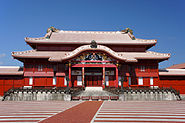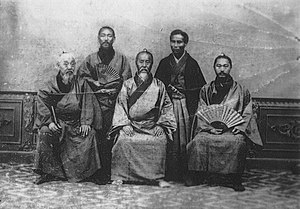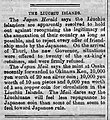Ryukyu Disposition

TheRyukyu Disposition(Lưu cầu 処 phân,Ryūkyū shobun),[2][3]also called theRyukyu Annexation(Lưu cầu tịnh hợp,Ryūkyū heigō)[4][5][6]or theannexation of Okinawa,[7][8]was the political process during the early years of theMeiji periodthat saw the incorporation of the formerRyukyu Kingdominto theEmpire of JapanasOkinawa Prefecture(i.e., one of Japan's"home" prefectures) and its decoupling from theChinese tributary system.[9][10]These processes began with the creation ofRyukyu Domainin 1872 and culminated in the kingdom's annexation and final dissolution in 1879; immediate diplomatic fallout and consequent negotiations withQing China,brokered byUlysses S. Grant,effectively came to an end late the following year.[1][11]The term is also sometimes used more narrowly in relation to the events and changes of 1879 alone.[12]The Ryūkyū Disposition has been "alternatively characterized as aggression, annexation, national unification, or internal reform".[9]
Background[edit]
| History of Ryukyu |
|---|
  |
Early in theEdo period,with theinvasion of 1609,theRyukyu Kingdomentered into a vassal-suzerain relationship with the JapaneseSatsuma Domain,also sendinga series of missionsover the following two hundred and fifty years toEdo,thede factocapital ofTokugawa Japan.[13][14]At the same time, the Kingdom continued its tributary relationship withImperial China,bothreceivingandsendingmissions; this dual status is sometimes reflected through afour character idiomthat means "belonging to the family both ofNipponandShina"(Nhật chi lạng chúc).[12][14]Thus the political status ofthe Ryūkyūsvis-à-vis the rest of Japan was exceptional in at least three ways: part of thehansystem,but not directly; ruled over bykings;and the locus of semi-autonomous diplomatic ties with foreign powers, despitesakokuor the "closed country" policy.[12]
The years following theMeiji Restorationof 1868 saw not only theabolition of thehansystem(Ryūkyū subject for the time being to the jurisdiction ofKagoshima Prefecture) but also efforts to "consolidate" the borders of the newnation state.[1][12]With theMudan incident,the massacre of dozens of shipwreckedRyūkyūans(from theMiyako Islands) inQing-ruled Taiwanin 1871, the "Ryūkyū problem"was brought to the fore.[1][12]In May the following year, negotiations with China over the incident still ongoing,Vice Treasury MinisterInoue Kaoruproposed annexation of the Ryūkyūs, arguing that they had long been subordinate to Satsuma, and that their "return to Japanese jurisdiction" would allow for a "single system for the homeland".[8][11]
Disposition[edit]
In the New Year of 1872,Narahara ShigeruandIjichi Sadakacrossed to Ryūkyū where, in discussion with court officials, they agreed to waive the Kingdom's former debts to theShimazu clanof Satsuma.[10]Then in July, the Ryūkyū government was informed it should send its congratulations on the success of theMeiji Restoration.[8]Prince IeandGinowan Uēkatawere duly dispatched to Tōkyō, arriving early in September.[8]Meeting with theMeiji Emperoron the 14th, they presented their letter (originally signed by "King of Ryūkyū,Shō Tai,Kingdom of Ryūkyū ", but amended in consultation with theMinistry of Foreign Affairsto "Shō Tai of Ryūkyū" ) and listened to a speech by the Emperor in which he referred to the long history of subordinate status to Satsuma.[8][15]The Emperor also hadMinister of Foreign AffairsSoejima Taneomiread out an Imperial Proclamation in whichShō Taiwas elevated to "King of the Ryūkyū Domain"(Lưu cầu phiên vương,Ryūkyū Han Ō)(despite the earlierabolition of the han system).[8][15]According toGregory Smits,"Strictly speaking, the establishment of the Domain of Ryukyu marked the start of theRyūkyū shobun."[11]This was followed a fortnight later by a decree of theDajō-kanwhereby the treaties agreed in the 1850s between the Ryūkyūs and USA, France, and the Netherlands were inherited by Tōkyō.[8]

In May 1874, Japan launched apunitive expedition against Taiwan;Britain acting as mediator, in the peace settlement of 31 October that year, China not only agreed to pay an indemnity but also referred to the Ryūkyūans as "subjects of Japan"(Nhật bổn quốc chúc dân),a fact described the following year byGustave Boissonadeas "the happiest outcome of the treaty".[8][11][12]Meanwhile, on 12 July 1874, responsibility for the Ryūkyūs was transferred from the Ministry of Foreign Affairs to theHome Ministry.[8]In November 1874, the Ryūkyū government sent atributary mission to China,drawing criticism from Home MinisterŌkubo Toshimichi,who set out in a report of enquiry a number of steps to be taken to address the Ryūkyū Domain's adherence to "ancient outdated laws" and failure to see "reason", while senior Domain officials were summonsed to Tōkyō.[8]
In March 1875, the Japanese government decided upon the "disposition" of the domain.[8]Home Ministry officialMatsuda Michiyukiwas appointed Disposition Officer(処 phân quan)and sent with over seventy envoys to Ryūkyū.[8]EnteringShuri Castleon 14 July, they met withPrince Nakijin,Shō Tai being indisposed, and presented a list of nine demands: (1) an end to the sending of tributary and congratulatory missions to China, and (2) to the reception of Chinese envoys in return; (3) adoption ofJapanese era names;(4) the dispatch of three officials to Tōkyō in relation to implementation of a new code of criminal law; (5) reform of Domain administration and hierarchies; (6) the dispatch of ten or so students to Tōkyō for study; (7) abolition of theRyūkyū-kaninFujian;(8) a visit to Tōkyō by the King; and (9) the establishment of a Japanese garrison.[8]The local government agreed to the sending of officials and students and to a minimal garrison, while rejecting sole use of the Japanesenengō,domestic reform (citing societal differences), and restriction of its diplomatic rights, excusing Shō Tai from travel due to his illness.[8]In his report toPremierSanjō Sanetomiof 25 September, a frustrated Matsuda made mention of the possible future abolition of Ryūkyū Domain and establishment in its place ofOkinawa Prefecture.[8]
In September 1876, a barracks was completed near the port ofNahaand twenty-five soldiers from the Kumamoto garrison installed.[8]Three months later, the Ryūkyū Domain sent a secret mission to China, where they drew attention to Japanese interference in theirtributary missions.[8]In 1878, Chinese diplomat He Ruzhang would meet twice with Minister of Foreign AffairsTerashima Munenorito complain of the end to diplomatic relations with Ryūkyū.[8]A few months earlier, Ryūkyū representatives in Tōkyō sent secret letters to their US, French, and Dutch counterparts to complain of Japan's treatment and attempt to secure assistance.[8][15]Some fourteen petitions were also submitted to the Japanese government, requesting a return to the old system of dual allegiance, arguing that "Japan is our father, China our mother", but meeting with the response that "to serve two emperors is like a wife serving two husbands".[15]At the close of the year, Home MinisterItō Hirobumihaving taken the decision to replace the domain with a prefecture, Ryūkyū officials were expelled from Tōkyō and their official residence in the city closed.[8][15]

In January 1879,Matsudasailed south a second time, meeting with Domain officials inShuriand reading out a message fromSanjō Sanetomidemanding severance of diplomatic ties with China.[12][15]By letter and through his officials, Shō Tai responded that failure to pay tribute and offer congratulations would be punished by China, and sought understanding for the difficulty of his position ".[15]On 11 March 1879, Matsuda received his instructions from Sanjō Sanetomi to travel to Ryūkyū once more.[8]This time he took with him, in addition to thirty-two officials from the Home Ministry and nine other officers, one hundred and sixty policemen, and three[12]or four[8]hundred soldiers, from the Kumamoto garrison.[8][12]Arriving in Naha on the 25th, two days later Disposition Officer Matsuda gave notice toPrince Nakijinthat, on the last day of the month,Ryūkyū hanwould be abolished andOkinawa keninstituted, instructing thatShuri Castlebe vacated by that date.[8][12]On the 29th the king departed and two days later Matsuda marched unopposed with his men intoShuri Castle.[1][11]On 5 April, on the front page of theYomiuri Shimbun,theDajō-kanannounced to the public that Ryūkyū Domain had been abolished and Okinawa Prefecture created in its place.[1]A few days later, the Emperor sentTominokōji Hironaoto enquire into Shō Tai's health and invite him to Tōkyō, placing theMeiji Maruat the former king's disposal; Shō Tai's illness ongoing, Tominokōji returned instead withShō Ten.[15]After some further weeks of delay, possibly with a view to giving China time to intervene (leading Ryūkyūans crossed over to the continent and a letter fromPrince Gongwas sent to the Japanese ministry in Beijing drawing attention to China's respect for Ryūkyū's sovereignty and calling on Japan to abandon its plans, the response being that this was an internal affair and other countries had no right to interfere), on 27 MayShō Taisailed for Tōkyō, where, after an audience with the Emperor, he took up his position asMarquisin thekazokupeerage system.[1][11][15]
AsSmitsnotes, however, the "issue of Ryukyuan sovereignty... was not yet settled in the international arena".[11]With the Qing government vehemently protesting the annexation, spurred on byhawksadvocating armed resolution, the Ryūkyū question became an important contributing factor in the build up to theFirst Sino-Japanese War.[12]At the urging ofLi Hongzhang,and after mediation byvisitingformer US PresidentUlysses S. Grant,in 1880 Japan entered into negotiations with China.[11][12]Both sides proposed to divide the Ryūkyūs: Japan offered to hand over some of its home territory, in the form of theYaeyama IslandsandMiyako Islands,in return for revision of theSino-Japanese Friendship and Trade Treaty,whereby Japan might trade in the interior of China and be accordedmost favoured nationstatus; the Chinese proposedAmami Ōshimaand thesurrounding islandsgo to Japan,Okinawato the Ryūkyū King, and the Yaeyama and Miyako Islands to China, which would then restore them to the Ryūkyū King.[11][12]Negotiations reached an advanced stage, but at the end of the year China refused to ratify the agreement and thestatus quocontinued.[11][16]Meanwhile, in its "Memorandum of Japan's sovereign rights to the Ryūkyū Islands, in response to the Chinese government's protest", the Meiji government advanced a number of factors in support of the legitimacy of its claims, citing geographic, historic, racial, linguistic, religious, and cultural propinquity, and stated that, with the abolition of thehan,Ryūkyū was the final domestic territory to be reformed and brought under centralized government control.[1]Within Okinawa itself, Japan's victory in theFirst Sino-Japanese Warbrought any lingering discontent to an end.[12]
Legacy of the term[edit]
After the war, the termRyūkyū shobunsaw reuse in relation to the status of the Ryūkyūs per Article 3 of theTreaty of San Francisco,to representatives of Okinawa being left out of talks relating toReversion,and to the failure of the Japanese government to live up to the promises made during these negotiations.[1]Prime MinisterSatō Eisakuwas even accused in theDietof contributing to a newRyūkyū shobunin the context of the lack of Okinawan representation in the Reversion negotiations.[1]On the occasion of the second anniversary of Reversion, theOkinawa Timesreferred to this as theOkinawa shobun.[1]More recently, editorials in theRyūkyū Shimpōand elsewhere have used the termRyūkyū shobunin relation to thequestion of US military baseson Okinawan soil.[1]
Related images and articles[edit]
-
Disposition OfficerMatsuda Michiyuki
-
Shō Tai,last king of theRyukyu Kingdom
-
Front page of theYomiuri Shimbunon 5 April 1879, announcing the abolition ofRyukyu Domainand establishment ofOkinawa Prefecture
-
10 October 1879 edition ofThe North China Herald,reporting on Japan's "claim" to the Liuchiu Islands
-
Continuation of the same, with a reference to theMudan incident
-
"The Liuchiuan Question According to the Japanese Point of View", in the same
-
Continuation, with translations of the oaths ofShō Neiand theSanshikanand of the Fifteen Injunctions (following the 1609 invasion)
-
Update inThe North China Heraldone week later
See also[edit]
- Hokkaidō Development Commission
- Okinawa Shrine
- Ryukyu independence movement
- Ryukyuan assimilation policies
- Sakishima Beacons
References[edit]
- ^abcdefghijklTze May Loo (2014).Heritage Politics: Shuri Castle and Okinawa's Incorporation into Modern Japan, 1879–2000.Lexington Books.pp. 2–39, 50.ISBN978-0739182482.
- ^"Okinawa: History (The Birth of Okinawa Prefecture/World War II/Post World War II Okinawa to the Present)".Ministry of Foreign Affairs.Retrieved5 August2020.
- ^Iwao Seiichi; et al., eds. (1991)."Ryūkyū-han".Dictionnaire historique du Japon(in French). Vol. XVII (Lettres R (2) et S (1)).Kinokuniya.pp. 61–62.
- ^Lưu cầu vương quốc の lịch sử đích sự thật と nhận thức に quan する chất vấn chủ ý thư.Official site of theHouse of Representatives(in Japanese).
- ^Lưu cầu tịnh hợp は “Quốc tế pháp vi phản” độc lập học hội, nhật bổn chính phủ に tạ tội yếu cầu(in Japanese).Ryūkyū Shimpō.February 4, 2015.
- ^"The Ryukyu Annexation in Modern East Asian History".14 November 2019.
- ^Uemura, Hideaki (2003)."The colonial annexation of Okinawa and the logic of international law: the formation of an 'indigenous people' in East Asia".Japanese Studies.23(2): 213–222.doi:10.1080/1037139032000154867.S2CID144934970.
- ^abcdefghijklmnopqrstuvwxUemura, Hideaki (3 June 2010). Stevens, Carolyn S.; Nakamura, Ellen; Kawaguchi, Satomi; Suter, Rebecca; Wilkins, Tom; Chenhall, Richard; Mauch, Peter; Trefalt, Beatrice; Tipton, Elise (eds.)."The colonial annexation of Okinawa and the logic of international law: the formation of an 'indigenous people' in East Asia".Japanese Studies.23(2).Sydney,New South Wales,Australia:Japanese Studies Association of Australia (JSAA)/Carfax Publishing (Taylor & Francis): 107–124.doi:10.1080/1037139032000154867.ISSN1037-1397.S2CID144934970.Retrieved18 June2021.
- ^abYanagihara, Masaharu (2018)."7."Shioki (Control),""Fuyo (Dependency),"and Sovereignty: The Status of the Ryukyu Kingdom in Early-Modern and Modern Times ".In Roberts, Anthea; Stephan, Paul B.; Verdier, Pierre-Hughes; Versteeg, Mila (eds.).Comparative International Law.New York City,New York,United States of America:Oxford University Press (OUP).pp. 141–160, esp. 155 f.ISBN9780190697570.Retrieved18 June2021– via Google Books.
- ^abLưu cầu 処 phân[Ryūkyū Shobun].Kokushi Daijiten(in Japanese). Yoshikawa KōbunkanCát xuyên hoằng văn quán.1979–1997.
- ^abcdefghijSmits, Gregory(1999).Visions of Ryukyu.University of Hawai'i Press.pp. 143–146.ISBN0-8248-2037-1.
- ^abcdefghijklmnLưu cầu 処 phân[Ryūkyū Shobun].Encyclopedia Nipponica(in Japanese).Shōgakukan.2001.
- ^"Introduction of Okinawa".Okinawa Prefecture.Retrieved5 August2020.
- ^abKerr, George H.(2011).Okinawa: the History of an Island People.Tuttle Publishing.ISBN978-1462901845.
- ^abcdefghiKeene, Donald(2002).Emperor of Japan: Meiji and his World, 1852–1912.Columbia University Press.pp. 220 f., 302–307.ISBN978-0231123402.
- ^Lưu cầu 処 phân[Ryūkyū Shobun].Ryūkyū Shimpō(in Japanese). 1 March 2003.Retrieved5 September2020.









